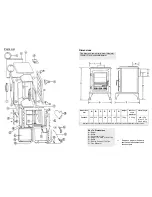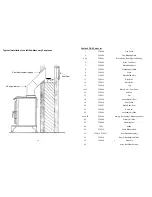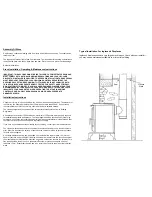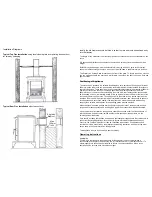
4
Assembly Of Stove
Remove legs, collar and blanking plate from stove and fit in desired position. The collar can be
fitted top or rear.
The legs can be fitted at front of ash lip or rearward. To make easier for handling on installation,
remove baffle plate, side bricks, back brick and door. Place in a secure place to avoid damage.
Refit after installation.
Stove Installation, Operating & Maintenance Instructions
IMPORTANT: THIS APPLIANCE MUST BE INSTALLED BY A COMPETENT PERSON AND
MUST COMPLY WITH NATIONAL BUILDING REGULATIONS AND LOCAL BY-LAWS.
UNLESS THE INSTALLER IS QUALIFIED TO APPROVE INSTALLATION THEN APPROVAL
MUST BE SOUGHT FROM YOUR LOCAL BUILDING CONTROL DEPARTMENT. THE
SUPPLIERS ACCEPT NO RESPONSIBILITY IF THIS ADVICE IS NOT COMPLIED WITH.
THIS APPLIANCE HAS BEEN EXTENSIVELY TESTED FOR SAFETY AND EFFICIENCY,
DO NOT ATTEMPT TO MODIFY IT. ALWAYS USE GENUINE REPLACEMENT PARTS AS
RECOMMENDED BY YOUR SUPPLIER. FAILURE TO ADHERE TO THIS ADVICE COULD
INVALIDATE YOUR GUARANTEE. WHEN OPERATING THE STOVE IN A SMOKE
CONTROLLED AREA, ONLY BURN SEASONED WOOD AND APPROPRIATE
SMOKELESS FUELS.
Installation Instructions
Check the chimney is in good condition, dry, free from cracks and obstructions. The diameter of
the chimney flue should not be less than 150mm and not more than 230mm. If any of these
requirements are not met, the chimney should be lined by a suitable method.
The chimney height and the position of the chimney terminal should conform to Building
Regulations.
A flue draught of minimum 12 Pascals and a maximum of 15 Pascals water gauge is required
for satisfactory appliance performance. The flue draught should be checked under fire at high
output and if it exceeds the recommended maximum, a draught stabiliser must be fitted so that
the rate of burning can be controlled, and to prevent overfiring.
If you have any doubts about the suitability of your chimney, consult your local dealer/stockist.
The chimney must be swept before connection to the stove and swept every six months there
after. If there is an excessive build up of soot, then the chimney must be swept and the reason
for build up investigated.
An existing fireplace opening can be bricked up or sealed with a register plate, 1.5mm steel
sheet or concrete. A short length of flue pipe no smaller in diameter then the stove flue outlet or
the manufacturer’s stated flue size may then be used to connect the stove to the chimney. This
flue pipe should be of cast iron, 316 grade stainless steel or vitreous enamelled, nominal
thickness 1.2mm. Ensure that the pipe end is no closer than 76mm to the side or rear chimney
walls.
Typical Installation For Inglenook Fireplaces
Inglenook fireplaces can have very large bore chimneys. Check with your installer—
you may need a stainless steel flexible liner for solid fuel fitting.
13
Closure
Plate
Seal


























